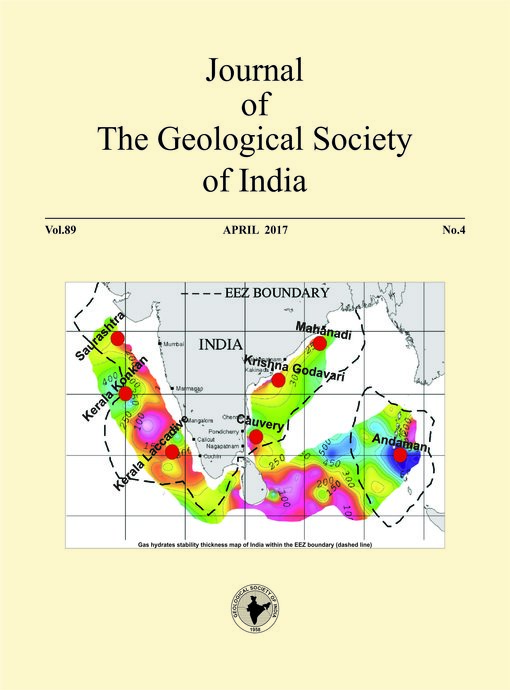Deciphering Heavy Metal Contamination Zones in Parts of Nalgonda District, Telangana
DOI:
https://doi.org/10.1007/s12594-017-0624-9Abstract
The study area is very important in terms of anthropogenic activity like rapid industrial, urban development, pesticides, pharmacy, granite polishing and agro based industries. Soils represent an excellent media to monitor heavy metal pollution. The results of soil samples analyzed in the present work using XRF reveal anomalous heavy metal and major oxide concentrations. The geogenic and anthropogenic activities for a long period in the study area are responsible for the anomalous heavy metal pollutants. Hence, this work is of immense societal benefit in terms of prevailing human health hazards in the study area with a direct relevance to such industrially populated regions elsewhere. Soil samples collected from study area were analyzed for heavy metals (As, Ba, Cr, Cu, Ni, Co, Mo, Pb, Rb, Sr, V, Y, Zn and Zr and major oxides (SiO2, Al2O3, Fe2O3, MnO, MgO, CaO, Na2O, K2O, TiO2, and P2O5 ) using Philips PW 2440 X-ray Fluorescence Spectrometer (XRF). The minimum 0.08 for molybdenum and maximum 21.99 enrichment factor for arsenic is observed. The minimum -2.5 and maximum 17.97 geoaccumulation index values is observed for barium and molybdenum. The minimum 0.07 and maximum 4.3 contamination factors is observed for molybdenum and lead. High contamination degree 19.21 for SMP-1 and least 7.8 for SMP-12 is observed. The minimum 0.41 and maximum 0.95 pollution load index is observed for SMP-12 and SMP-20. Factor analysis results shows that, three factors emerged as significant contributors to the soil quality is about seventy six percent for heavy metals and sixty eight percent for major oxides. The spatial variation maps deciphering heavy metal concentration of both natural and anthropogenic origin by three zones i.e. low, moderate and high of the study area based on environment using Arc-GIS.Downloads
Metrics
Issue
Section
Downloads
Published
How to Cite
References
Abrahams, P.W. (2002) Soils: their implications to human health. The science of the Total Environ., v.291(1-3), pp.1-32.
Bohn, L.H., McNeal, L.B., O'Connor, A.G. (2001) Soil Chemistry. 2nd edn. (John Wiley: New York).
Chang, A.C., Warneke, J.E., Page, A.L. and Lund, L.J. (1984) Accumulation of heavy metals in sewage sludge treated soils. Jour. Environ. Qual., v.13, pp.87-91.
Frink, C.R. (1996) A perspective on metals in soils. Jour. Soil Contamination, v.59, pp.329-359.
Govil, P.K., Reddy, G.L.N. and Krishna, A.K. (2001) Contamination of soil due to heavy metals in Patancheru industrial development area, Andhra Pradesh, India. Environ. Geol., v.41, pp.461-469.
Hakanson, L. (1980) An ecological risk index for aquatic pollution control. A Sedimentological approach. Water Resour. Res., v.14, pp.975-1001.
Krzysztof, L., Wiechula, D. and Korns, I. (2004) Metal contamination of farming soils affected by industry. Environment International, v.30, pp.159-165.
Lall, U. and Sharma, A. (1996) A nearest neighbor bootstrap for re-sampling hydrologic time series. Water Resur. Res., v.32(3), pp.679-694.
Pendias, K.A. and Mukherjee, B.A. (2007) Trace Elements from Soil to Humans. Springer, Berlin, pp.93-94.
Romic, M. and Romic, D. ((2003) Heavy metal distribution in agricultural top soils in urban area. Environ. Geol., v.43, pp.795-805.
Salomons, W. and Forstner, U. (1984) Metals in the Hydrocycle. Berlin Heidelberg: Springer-Verlag. pp.349.
Smith, K.A. and Paterson, J.E. (1995) Manganese and cobalt: Heavy Metals in Soils (Glasgow: Chapman & Hall), pp.224–244.
Taylor, S.R. and Mclennan, S.M. (1995) The geochemical evolution of the continental crust. Rev. Geophys., v.33, pp.241-265.
Tomlinson, D.C., Wilson, J.G., Harris, C.R. and Jeffrey, D.W., (1980) Problems in the assessment of heavy-metal levels in estuaries and the formation of a pollution index. Helgoland Mar. Res., v.33, pp.566-575.
Turekian, K.K. and Wedepohl, K.H. (1961) Distribution of the elements in some major units of the earth's crust. Geol. Soc. Amer. Bull., v.72, pp.175-192.

 Dasu Purushotham
Dasu Purushotham






